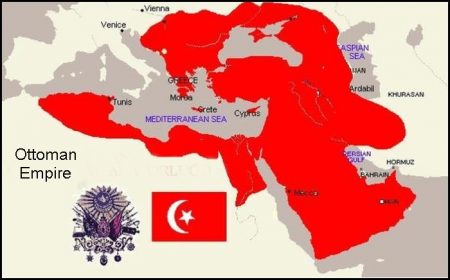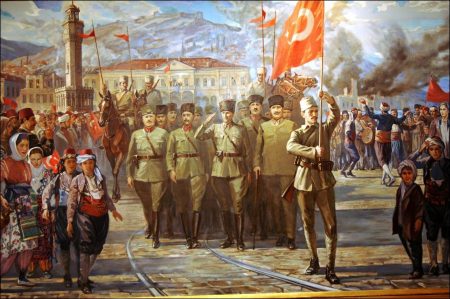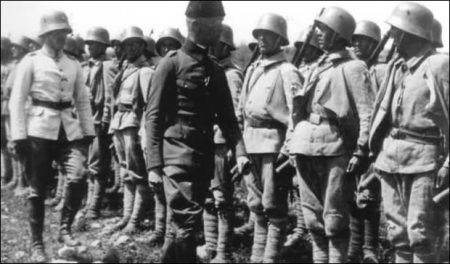The most fascinating aspect of the Ottoman army in the First World War was that it was able to fight for as long as possible, even though it had been defeated against four small Balkan states a year ago. The general opinion between the British and the French is that this success was entirely due to the efforts of the German officers who served the empire during the war. However, the truth is that it was the result of reforms made by the leader of the Young Turks and the Ottoman War Minister Enver Pasha and his German advisers in the year following the Balkan war. The reforms introduced a number of older officers to retire, replacing them with contemporary trained young officers.
In the opinion of German observers, these young officers were well acquainted with modern warfare techniques on a theoretical basis. Thanks to them, great improvements have been achieved, especially at the management level. However, since all of their experiences were at the level of general administration, for the first time when they took over the units in the field, they experienced a lack of command experience. The better defense performance of the army compared to the moment of the offensive was attributed to the inadequacy of experienced sergeant and corporal to lead the troops. Because most of the experienced corporal and sergeants died during the Balkan War of 1912-1913.
The army, which these officers had to manage, had to deal with two problems that were almost impossible to overcome: the shortage of manpower and the lack of communication (communication) ğ We will return to the issue of lack of communication in the title of the army’s discussion of supply conditions. The issue of lack of manpower has been a problem for the Ottomans throughout the 19th century, when it faced confronted European armies with compulsory military service. Despite its rapid growth over the past 30 years, the Ottoman population was still relatively small. There were only 19 million inhabitants in the major states. The population was perhaps between 23 and 25 million, including the surrounding states where no reliable census was conducted.
On the other hand, it was not possible for all men of this population to be taken to military service. Because non-Muslims (Christians and Jews, who make up 20 percent of the population in 1914) pay exemption tax called “price,, so they are not recruited. Many Muslims also used this opportunity, but the exemption tax they paid was considerably higher. Those who could afford this money were mostly among the children of wealthy families living in cities.

The young Turkish government began to impose the recruitment of non-Muslims from 1909 onwards. In practice, however, most Christians were still able to avoid military service. They did this by paying more money than the Muslims. The Greeks and Armenians, who were poorer than Christians and could not pay the necessary taxes, were employed in unarmed battalions such as digging trenches and carrying ammunition during the war. In practice, Christians could not go beyond the rank of lieutenant. The only exception was that the army doctors could rise to the rank of captain.
Not only the Christians were discriminated against.
As far as I can tell, troops in the Ottoman Army were ethnically structured. This could be at the level of regiment or even division. German officers generally call them “Arab divisions” and “Turkish divisions”. British reports have the same classification. “51. The division consists of a combination of Anatolian Turks and Kurds ”and“ 141. and 142. Divisions are a combination of Arabs and Syrians ”. Each regiment is estimated to have its own form of recruitment. There were, however, exceptions. We found evidence of mixed troops. However, the existence of these mixed units was probably due to the disintegration or unification of many troops due to the loss of power in the final stages of the war.
A large number of Arab troops were used primarily in garrison services and in communications. However, as a result of the lack of manpower during the war, the Ottoman government was forced to use Syrian and Iraqi Arabs in the units fighting at the front. Towards the end of the war, 4 of the 10 regiments on the Palestinian front were Arabs. However, these were considered as lower class according to Turkish troops. An example of this was seen during the exchange of prisoners of war. The Ottoman government insisted that gerçek real Turkish soldiers, not Arabs, ”be given in return for returning British soldiers. He offered only Indian soldiers to take back the Arabs.
In the opinion of Liman von Sanders, Arab troops were not seen as bad people in the Ottoman Empire, but they were thought to need “strict command”. In describing the Arabs, Kress described it as dolu more vivid and intelligent but less reliable than the Anatolian troops ”. The nomadic tribes of the empire, including the other Kurds, also contributed to the war, but mostly served in cavalry units with loose ties to the regular army. Therefore, the benefit of the Kurds was extremely limited. As a result, the entire burden of regular troops in the front, 40 percent of the total population and the number of 9-10 million people in Anatolia had to carry a population of Turkish villagers.
With the cancellation of the exemption tax instead of military service, 100,000 men were called to military service every year. However, only three quarters of them joined the army. The other quarter was rejected for health reasons. This meant that the army’s power during the peacetime was 150,000. There is uncertainty about the army’s mobilization power, but the maximum number of people under arms at any given time was probably just under 800,000. The mobilization, however, was extraordinarily slow, and it took at least six months to fully engage. This meant that even after all the mobilization, only 4% of the population was under arms and on active duty. Considering that this rate is 10% in France, which has a double population, there will be a lack of mobilization.
At the time of the mobilization in the Ottoman Empire, men aged between 19 and 45 were called for service. However, by 1916, the age limits were extended from 15 to 55 years. According to British reports in 1917, 12% of the total number of men was between 16 and 19 years of age.
With the new military service law enacted in April 1915, the number of men excluded from military service was limited. However, the opportunity to pay taxes instead of military service was left. On the other hand, the amount of the tax was increased to 50 Turkish Liras by increasing astronomically. Soon, Muslim foreigners living in the imperial lands began to be drafted. In 1914, the Sultan announced that they should join the jihad, which means holy war. However, they could buy the military by paying 45 pounds. These measures, which were undoubtedly useful, had little contribution to the strength of the army.
Visits: 305




